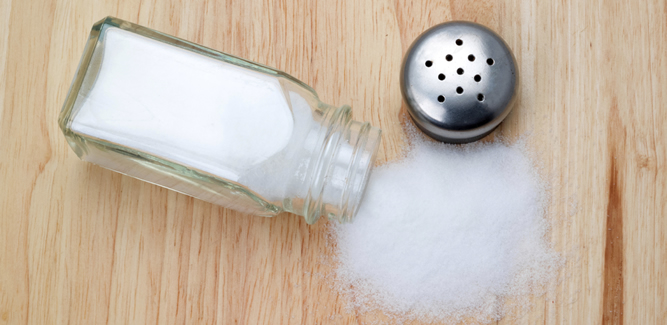So how much salt is the right amount?

The reason we are regularly told to cut down on salt is largely because, on average, our diet includes roughly double the amount of salt we should ingest. Although everybody is different, and we all have individual dietary needs, it is generally recommended that we eat no more than 6g of salt each day, approximately one teaspoonful.
This does not mean that on one meal we can sprinkle a full teaspoon of salt – in fact, most of the salt we eat is already present in foods, including in cereals, meats and bread. This is why we often do not realise or understand exactly how much salt we are consuming.
What happens if I don’t eat enough salt?
Salt, which contains two minerals called sodium and chloride, is a vital component of our diet, helping to maintain the correct balance of fluid in the body, supporting muscle function and ensuring that the nerves are effectively transmitting signals.
It is unusual to suffer from a sodium chloride deficiency, but this can occur with persistent and severe vomiting or diarrhoea, in those who have a very restricted diet, such as a raw food diet, or in those who have a medical condition, such as a liver disorder, which can result in depletion of the body’s source of sodium.
Should a salt deficiency occur, symptoms may include dizziness and fainting, nausea and vomiting, muscle cramps and disorientation. These symptoms can be reversed relatively quickly by restoring an adequate level of salt into the diet.
And what if I eat too much salt?
Eating too much salt is a far more common problem, which can lead to a range of health concerns over time. Primarily, too much salt can lead to fluid retention in the body, which increases the strain on the heart. This can lead to high blood pressure, and increase the risk of cardiovascular disease or stroke.
Additionally, too much salt can cause depletion of the body’s resources of calcium, leading to decreased bone density and fragility in the joints. The loss of calcium can also lead to an increased risk of kidney stones, or improper functioning of the kidneys.
So what can I do to reduce salt intake?
The first step to ensuring you are consuming the right amount of salt is to keep a note of how much salt you are eating and its source. This helps you to identify what and how much you need to change. This includes the quantity of salt you are adding to food, as well as keeping track of nutrition labels on packaged food. Many people find that most of the salt in their diet comes from processed food, so, for many, making small changes to the types of food they are eating is more effective than simply reducing the amount of salt being added.
Take a look at this food and salt diary for one day:
| Breakfast | Bowl of cornflakes | 0.65g |
| Cup of coffee | 0.005g | |
| Lunch | Ham and egg sandwich | 2.1g |
| Salt and vinegar crisps | 0.41g | |
| Bar of chocolate | 0.15g | |
| Cup of tea | 0.005g | |
| Tea | Packaged Tikka Masala Curry | 2.9g |
| Naan Bread | 1g | |
| Orange juice | 0.1g | |
| Supper | Hot Chocolate | 0.58g |
| 2 digestive biscuits | 0.2g | |
Total |
8.1g |
This shows that before any salt is added to your food, it is already possible to be consuming more than the recommended daily allowance, in this case more than a third in excess.
There are many tips you can try to help you in your struggle against salt:
- Use fresh fruit and vegetables – these are naturally low in sodium, as well as being a vital part of a healthy balanced diet. Fresh frozen fruit and vegetables are also naturally low in sodium; if tinned, check that they are stored in water or natural juices.
- Use fresh meat – if you have meat, such as bacon or ham, which lasts well in the fridge for up to a week, then this is usually an indication that it has a high salt content. Fresh meat will only keep for a day or two at the most, as, although it does contain sodium, it is in much smaller quantities than in processed meats.
- Rinse tinned foods – tinned foods often contain a certain amount of salt as a preservative. If you give the food a good rinse before eating or cooking, this helps to wash away excess salt.
- Beware of sodium in disguise – many foods, including sauces, cottage cheese and sweet treats, do not taste as if they are high in salt. However, it is worth checking the labels, as often they are higher in salt than you may realise. Compare brands to find the one with the lowest salt content or, where possible, make your own sauces, giving you much greater control over how much salt you are adding.
- Cut down on eating out – the convenience of fast food or going out for a meal means that this is a very easy option after a busy day at work. However, fast food is notoriously high in sodium, and is likely to cause your low-sodium intentions to go spiralling downwards. It can be difficult to quantify the salt in meals at restaurants so, unless the restaurant is able to tell you the sodium content of various dishes, keeping track can become difficult.
- Swap your snacks – many snacks are very high in salt, such as crisps, pretzels or salted nuts. Instead, go for natural snacks, including unsalted nuts, raw carrot or celery sticks or fruit.
I don’t like the taste of food without salt in it
This is one of the most common cries which issue forth from the mouths of those who have been prescribed with a low-sodium diet. Salt is an addictive ingredient, and it is easy to notch up the amount of salt in our food incrementally, without realising we are consuming far more salt than we should.
It is almost as easy, however, to keeping cutting back a little on salt, and soon our taste buds adapt to the new flavour. In fact, it does not take long before people struggle to eat food with the high quantity of salt they were once used to.
 One of the best things you can try in the transition process is to use plenty of other herbs and spices. Black pepper, ginger, cinnamon and coriander, for example, all add a great flavoursome boost to a dish, helping to disguise the absence of salt.
One of the best things you can try in the transition process is to use plenty of other herbs and spices. Black pepper, ginger, cinnamon and coriander, for example, all add a great flavoursome boost to a dish, helping to disguise the absence of salt.
Also, you could try a salt substitute, such as from the Herbamare® range, which contains 12 fresh organically grown herbs, kelp and sea salt. This is a tasty alternative to table salt to help you to reduce your salt intake.
Do you have tips and tricks to share to help reduce your salt intake?





 Looking for our products in a store near you?
Looking for our products in a store near you?
